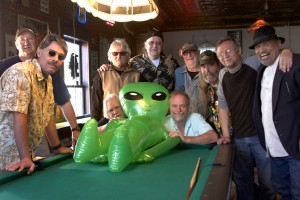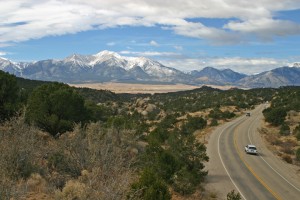by George Sibley
Recently it became official – globally, there are now more city cousins than country cousins. In other words, more than half of all humans live in large urban concentrations. We central Coloradans are now part of a global minority, which is probably not that much of a surprise here, where our state’s population is closer to three-quarters metropolitan.
A short essay in Newsweek (1/25/2010) tried to celebrate the fact that we are “adding the equivalent of seven New Yorks to the planet every year.” This means the most important locus (sic) for 21st-century innovation – technological, economic, and societal – will be our cities. They present the most promising opportunity to make our planet smarter. Cities bring together the systems by which our world works and include education, transportation, public safety, and health care, among others.”
That excerpt might tip you off that this Dr. Pangloss (the author of the essay) is a bureaucrat – in this case, a corporate bureaucrat, CEO for an information company. His essay splashes around all the usual words – innovation, smart, creativity, talent, smarter, investment, systems, and did I mention smart and smarter? But the thick thread running through it involved terms like “systems engineering” and “managing people” for “a more efficient, prosperous, and progressive world … if we can make [the cities] smarter.”
He lost me when he started raving about how wonderful it is that “car ownership in emerging markets is growing from less than one in 10 people to one in three.” This is fine to him because Stockholm (not exactly an “emerging market”) has “implemented a congestion-management system that reduced traffic by 18 percent.” Next, Mexico City, maybe?
The essay made me wonder if this guy’s handlers used a “Bush filter” on the news of the world he receives, but probably his view of the city is mostly what he sees through the side windows of his limousine, on his way to work at one of the companies who share the motto: “What’s good for (insert corporate name) is what’s good for America and the world.” It is probably easier to celebrate the futuristic potentially integrated systems of cities if you see yourself as the brains running the systems rather than as a grunt in the belly and bowels of the beast.
I do have to ask myself if maybe such efforts to “put a high polish on a horse apple,” as a country cousin says, aren’t fundamentally a good thing. This is the world we have, so might as well try to make the best of it.
But what this triumphalist tale misses are all the increasingly dysfunctional conditions of the urbanizing societies it wants to celebrate. What’s going to be happening to our atmosphere when one in three people have automobiles? What’s going to happen to all our coastal cities when sea levels rise ten or twenty feet? What’s going to replace petroleum as the foundational energy resource for this whole cobbled-together set of Rube Goldberg systems? What do we do about the mountains of debt piling up, the extent to which we have squandered the future to pay down the present, as well as the past?
To say that we have plausible answers to those questions begs the question: is there any evidence at all that we have political and economic systems in place (to use Dr. Pangloss’s terminology) with the will or moral strength to effect those answers? Any serious look at our nation-state government answers that question with incredulous laughter. The only thing our alleged leaders can agree on is to continue the petro-wars. And drug wars, and terror wars. To a man with a hammer, everything looks like a nail, and to a nation with its wealth tied up in the world’s most massive and expensive war machine ever, everything looks like a war.
Rather than the triumphant “ascent of man” tale that Dr. Pangloss lays out for us in Newsweek, I find more convincing the darker, sort of tragic tale one can construct out of the work of modern anthropologists and paleontologists. Warning: I’m putting together a lot of pieces here, and making a couple of hypothetical leaps that would horrify a real scientist. But if Dr. Pangloss can do it, so can I – incorporating a lot of the more sobering things that Dr. Pangloss had to leave out of his little pep talk.
Assembling a larger picture of the “natural history” of the human species, we see our 6,000 years of recorded history as a jerkstop episode of often inspired, but mostly frantic massive urbanization, punctuated by periods of massive cultural collapse. And that comparatively short episode of city-building and city-abandonment sits atop 10,000 to 20,000 years of transition from many, many millennia of hunting and gathering to what might be called “defensive herding and farming.” What precipitated these relatively sudden changes for the human species was an ongoing population explosion following the global warming that ended the last Ice Age.
Told like a story: after one to maybe four million years of wandering the cold and hot drylands of the Pleistocene, our defining characteristics – a big brain and great manual dexterity – were honed, making us remarkably adaptive to any of the planet’s then-harsh environments. After all that, the earth mellowed, and humans thrived. Thrived so well, in fact, that the growing populations of hunter-gatherers started competing for the large territories that hunter-gathers need. Out-and-out warfare began to replace the pissing on borders that had previously sufficed, and the hunters had to become herders, the gatherers had to become farmers, all protecting their food supplies from other groups. But these adaptations to crowding only seemed to bump the unfolding slow-mo population explosion up a few notches. We had to go to even more intensive and concentrated forms of cultural organization – the city-building period we are still trying to get right, without leaving an abandoned civilization that would dwarf all the previously abandoned similar efforts put together.
A swarming species, our formative time was spent developing an adaptive brain that worked well out on the lonely steppes and deserts of the Ice Age, but seems to overheat and go a little crazy when things get too dense and tense around it. Over the past 150 years, we expended most of the planet’s accumulation of fossil fuels in the most brilliant explosion of art, science and technology the planet has ever seen. We’ve literally changed the planet into “our thing,” including things we never meant to change, like the climate.
The dark side of all this is the extent to which a lot of that effort, maybe most of it, is part of an ongoing and increasingly dysfunctional attempt to avoid confronting the consequences of our ongoing 25 or 30 thousand-year population explosion, and the planet’s natural systems for restoring balance when a population swarms. Not enough food? We’ll create a Green Revolution! Diseases? AIDS? We’ll lick ’em all! Resource limits? Huh? If we aren’t growing, we’re dying! A couple issues after Dr. Pangloss’s paean to the urbanizing of the swarming species, Newsweek’s cover story was “The Science of Living Longer” – as though what we really needed now was for everyone to stay around forever. At this point, I think it is fair to call all of this effort a very creative, inspired, and systematized denial of the reality that has haunted our 6,000 years of recorded history, with its litter of fantastic urban ruins surrounded by wastelands.
So far as I’m concerned, cities are okay places to visit, but I don’t want to live in one. I either don’t think and move fast enough to survive in the city, or I just don’t want to. Either way, it just isn’t who I am, and I can look around me on a visit to the city and see hundreds and thousands of others like me, who are not blooming in the city. It makes me think of Thoreau’s observation on the railroad: “Though a crowd rushes to the depot, and the conductor shouts ‘All aboard,’ when the smoke is blown away and the vapor condensed, it will be perceived that a few are riding, but the rest are run over …” That’s the city – except in the city, the “few that ride” don’t run over the rest; they just get them in harness. And the harder the riders ride the ridden, the better our corporate Dr. Pangloss likes it; that’s system “efficiency” and increased productivity.
But I am also aware that my desire to not live in a city is not rational or helpful in this day and age. It is, in fact, basically pretty selfish. I’ve discovered that I can enjoy almost all of the fruits of an urban civilization without having to experience most of its immediate drawbacks. So, I’m living out here in a lovely but remote valley where big trucks and pipes and transmission lines deliver the goods and services of civilized life regularly and faithfully, all at prices that I know are heavily subsidized by the concentrated populations of the Front Range metropolis. I know those big trucks will not roll so cheaply forever, but for now they do.
Were I a farmer or producer of some of the other raw goods that the cities need, there would be some rationale for my existence out here. But I’ve lived here mostly by my wits, contributing semi-finished thoughts and stories to the inundation of information we all enjoy today. This enables me to contribute modestly to the Ponzi scheme of penny-passing we call an economy. However, I think there is a deeper economy of life in which I am even less unsustainable over here in this lovely valley than are those cities we are supposed to celebrate as our greatest achievements. I don’t really like this nation-state of denial I live in, and I think I’d like to join with others in really trying to figure out something constructive to do about it. So I think, anyway, most of the time. But sometimes, I just lay back and selfishly enjoy the last days of the life I have come to know.
George Sibley was born in Western Pennsylvania, but was conceived in Colorado by Colorado natives, and thus considers himself to be a native Coloradan.

